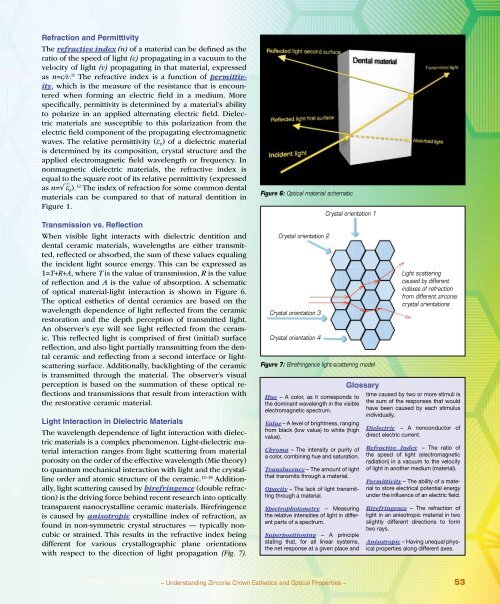PDF Download - Glidewell Dental Labs
PDF Download - Glidewell Dental Labs
PDF Download - Glidewell Dental Labs
You also want an ePaper? Increase the reach of your titles
YUMPU automatically turns print PDFs into web optimized ePapers that Google loves.
Refraction and Permittivity<br />
The refractive index (n) of a material can be defined as the<br />
ratio of the speed of light (c) propagating in a vacuum to the<br />
velocity of light (v) propagating in that material, expressed<br />
as n=c/v. l1 The refractive index is a function of permittivity,<br />
which is the measure of the resistance that is encountered<br />
when forming an electric field in a medium. More<br />
specifically, permittivity is determined by a material’s ability<br />
to polarize in an applied alternating electric field. Dielectric<br />
materials are susceptible to this polarization from the<br />
electric field component of the propagating electromagnetic<br />
waves. The relative permittivity (ε r ) of a dielectric material<br />
is determined by its composition, crystal structure and the<br />
applied electromagnetic field wavelength or frequency. In<br />
nonmagnetic dielectric materials, the refractive index is<br />
equal to the square root of its relative permittivity (expressed<br />
as n= ε r ). 12 The index of refraction for some common dental<br />
materials can be compared to that of natural dentition in<br />
Figure 1.<br />
Transmission vs. Reflection<br />
When visible light interacts with dielectric dentition and<br />
dental ceramic materials, wavelengths are either transmitted,<br />
reflected or absorbed, the sum of these values equaling<br />
the incident light source energy. This can be expressed as<br />
1=T+R+A, where T is the value of transmission, R is the value<br />
of reflection and A is the value of absorption. A schematic<br />
of optical material-light interaction is shown in Figure 6.<br />
The optical esthetics of dental ceramics are based on the<br />
wavelength dependence of light reflected from the ceramic<br />
restoration and the depth perception of transmitted light.<br />
An observer’s eye will see light reflected from the ceramic.<br />
This reflected light is comprised of first (initial) surface<br />
reflection, and also light partially transmitting from the dental<br />
ceramic and reflecting from a second interface or lightscattering<br />
surface. Additionally, backlighting of the ceramic<br />
is transmitted through the material. The observer’s visual<br />
perception is based on the summation of these optical reflections<br />
and transmissions that result from interaction with<br />
the restorative ceramic material.<br />
Light Interaction in Dielectric Materials<br />
The wavelength dependence of light interaction with dielectric<br />
materials is a complex phenomenon. Light-dielectric material<br />
interaction ranges from light scattering from material<br />
porosity on the order of the effective wavelength (Mie theory)<br />
to quantum mechanical interaction with light and the crystalline<br />
order and atomic structure of the ceramic. 12–18 Additionally,<br />
light scattering caused by birefringence (double refraction)<br />
is the driving force behind recent research into optically<br />
transparent nanocrystalline ceramic materials. Birefringence<br />
is caused by anisotropic crystalline index of refraction, as<br />
found in non-symmetric crystal structures — typically noncubic<br />
or strained. This results in the refractive index being<br />
different for various crystallographic plane orientations<br />
with respect to the direction of light propagation (Fig. 7).<br />
Figure 6: Optical material schematic<br />
Crystal orientation 2<br />
Crystal orientation 3<br />
Crystal orientation 4<br />
Crystal orientation 1<br />
Figure 7: Birefringence light-scattering model<br />
Hue – A color, as it corresponds to<br />
the dominant wavelength in the visible<br />
electromagnetic spectrum.<br />
Value – A level of brightness, ranging<br />
from black (low value) to white (high<br />
value).<br />
Chroma – The intensity or purity of<br />
a color, combining hue and saturation.<br />
Translucency – The amount of light<br />
that transmits through a material.<br />
Opacity – The lack of light transmitting<br />
through a material.<br />
Spectrophotometry – Measuring<br />
the relative intensities of light in different<br />
parts of a spectrum.<br />
Superpositioning – A principle<br />
stating that, for all linear systems,<br />
the net response at a given place and<br />
Glossary<br />
Light scattering<br />
caused by different<br />
indexes of refraction<br />
from different zirconia<br />
crystal orientations<br />
time caused by two or more stimuli is<br />
the sum of the responses that would<br />
have been caused by each stimulus<br />
individually.<br />
Dielectric – A nonconductor of<br />
direct electric current.<br />
Refractive Index – The ratio of<br />
the speed of light (electromagnetic<br />
radiation) in a vacuum to the velocity<br />
of light in another medium (material).<br />
Permittivity – The ability of a material<br />
to store electrical potential energy<br />
under the influence of an electric field.<br />
Birefringence – The refraction of<br />
light in an anisotropic material in two<br />
slightly different directions to form<br />
two rays.<br />
Anisotropic – Having unequal physical<br />
properties along different axes.<br />
– Understanding Zirconia Crown Esthetics and Optical Properties – 53

















